Glass matrix-facilitated thermal reduction: a tool for probing reactions of met hemoglobin with nitrite and nitric oxide
- PMID: 20146537
- PMCID: PMC2858684
- DOI: 10.1021/jp909425z
Glass matrix-facilitated thermal reduction: a tool for probing reactions of met hemoglobin with nitrite and nitric oxide
Abstract
Isolating elemental steps that comprise a protein reaction in solution is a difficult process. In this study, the use of sugar-derived glass matrices is evaluated as a biophysical tool to help dissect out elemental steps and isolate intermediates. Two features of the glass are utilized in this endeavor: (i) the capacity of trehalose glass matrices to support thermal reduction over macroscopic distances; and (ii) the ability of glass matrices to significantly damp large amplitude protein dynamics. The focus of the study is on the reaction of nitric oxide (NO) with a nitrite ion coordinated to the heme iron of hemoglobin (Hb). The thermal reduction property of the glass is used to generate NO from nitrite within the glass, and the damping of protein dynamics is used to control entry of NO into the distal heme pocket of Hb, where it can either interact with bound nitrite or bind to the heme iron. The results not only relate to earlier controversial studies addressing the reactions of Hb with NO and nitrite but also raise the prospect that these properties of sugar-derived glassy matrices can be exploited as a new biophysical tool to modulate and probe reactions of NO with hemeproteins as well as a wide range of other metalloproteins.
Figures
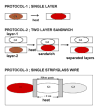
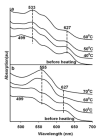
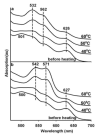
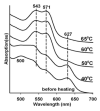
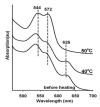
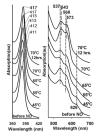
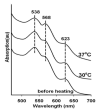
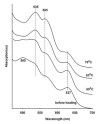
Similar articles
-
Hemoglobin as a nitrite anhydrase: modeling methemoglobin-mediated N2O3 formation.Chemistry. 2011 May 27;17(23):6348-58. doi: 10.1002/chem.201003578. Epub 2011 May 17. Chemistry. 2011. PMID: 21590821 Free PMC article.
-
Reactivity of glass-embedded met hemoglobin derivatives toward external NO: implications for nitrite-mediated production of bioactive NO.J Am Chem Soc. 2009 Sep 2;131(34):12273-9. doi: 10.1021/ja903364h. J Am Chem Soc. 2009. PMID: 19663497 Free PMC article.
-
Concerted nitric oxide formation and release from the simultaneous reactions of nitrite with deoxy- and oxyhemoglobin.J Biol Chem. 2007 Apr 27;282(17):12916-27. doi: 10.1074/jbc.M700546200. Epub 2007 Feb 23. J Biol Chem. 2007. PMID: 17322300
-
The new chemical biology of nitrite reactions with hemoglobin: R-state catalysis, oxidative denitrosylation, and nitrite reductase/anhydrase.Acc Chem Res. 2009 Jan 20;42(1):157-67. doi: 10.1021/ar800089j. Acc Chem Res. 2009. PMID: 18783254 Review.
-
Methemoglobin--it's not just blue: a concise review.Am J Hematol. 2007 Feb;82(2):134-44. doi: 10.1002/ajh.20738. Am J Hematol. 2007. PMID: 16986127 Review.
Cited by
-
Generating S-nitrosothiols from hemoglobin: mechanisms, conformational dependence, and physiological relevance.J Biol Chem. 2013 Aug 2;288(31):22408-25. doi: 10.1074/jbc.M113.482679. Epub 2013 Jun 17. J Biol Chem. 2013. PMID: 23775069 Free PMC article.
-
Hemoglobin as a nitrite anhydrase: modeling methemoglobin-mediated N2O3 formation.Chemistry. 2011 May 27;17(23):6348-58. doi: 10.1002/chem.201003578. Epub 2011 May 17. Chemistry. 2011. PMID: 21590821 Free PMC article.
-
Mechanisms of human erythrocytic bioactivation of nitrite.J Biol Chem. 2015 Jan 9;290(2):1281-94. doi: 10.1074/jbc.M114.609222. Epub 2014 Dec 3. J Biol Chem. 2015. PMID: 25471374 Free PMC article.
-
Sustained release nitric oxide from long-lived circulating nanoparticles.Free Radic Biol Med. 2010 Aug 15;49(4):530-8. doi: 10.1016/j.freeradbiomed.2010.04.034. Epub 2010 May 9. Free Radic Biol Med. 2010. PMID: 20460149 Free PMC article.
-
Biodegradable Nanoparticles for Delivery of Therapeutics in CNS Infection.J Neuroimmune Pharmacol. 2017 Mar;12(1):31-50. doi: 10.1007/s11481-016-9692-7. Epub 2016 Jul 2. J Neuroimmune Pharmacol. 2017. PMID: 27372507 Free PMC article. Review.
References
-
- Colaco C, Sen S, Thangavelu M, Pinder S, Roser B. Biotechnology (N Y) 1992;10:1007. - PubMed
-
- Crowe JH, Crowe LM, Chapman D. Science. 1984;223:701. - PubMed
-
- Liao YH, Brown MB, Nazir T, Quader A, Martin GP. Pharm Res. 2002;19:1847. - PubMed
-
- Newman YM, Ring SG, Colaco C. Biotechnol Genet Eng Rev. 1993;11:263. - PubMed
-
- Dantsker D, Samuni U, Friedman JM, Agmon N. Biochim Biophys Acta. 2005;1749:234. - PubMed
Publication types
MeSH terms
Substances
Grants and funding
LinkOut - more resources
Full Text Sources
Miscellaneous

